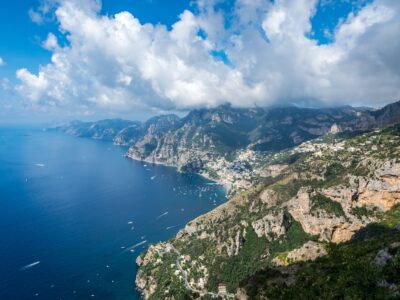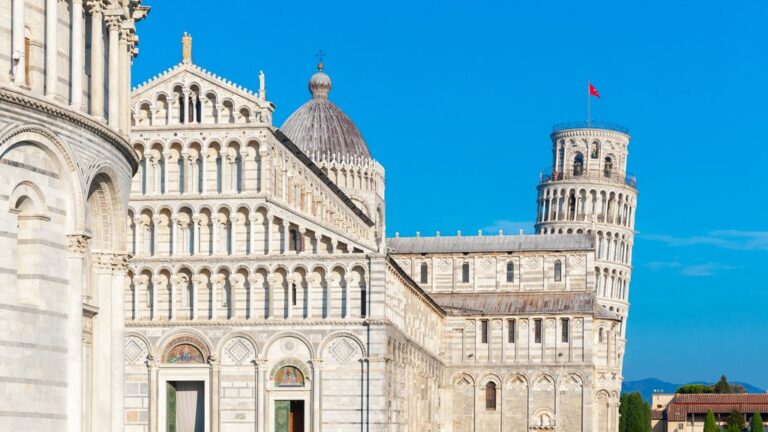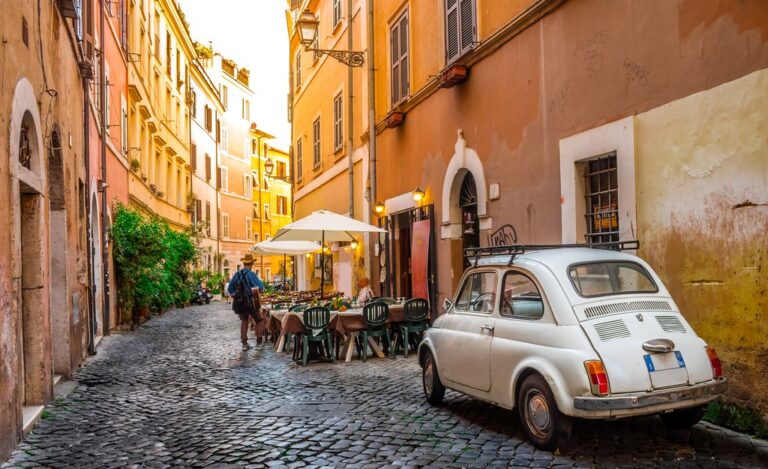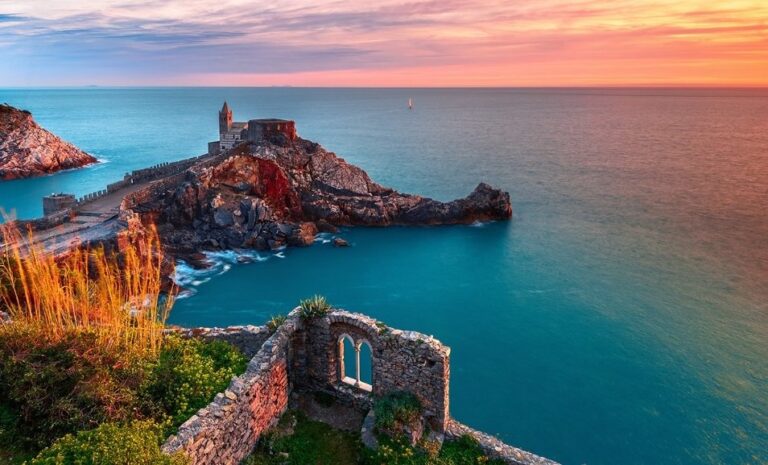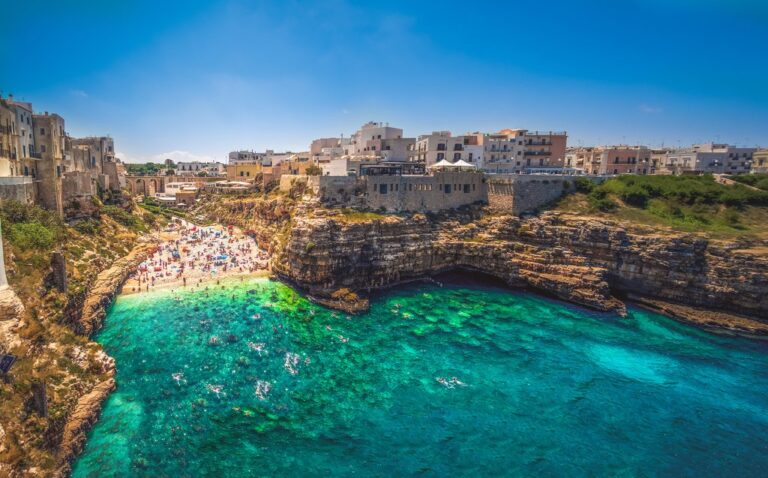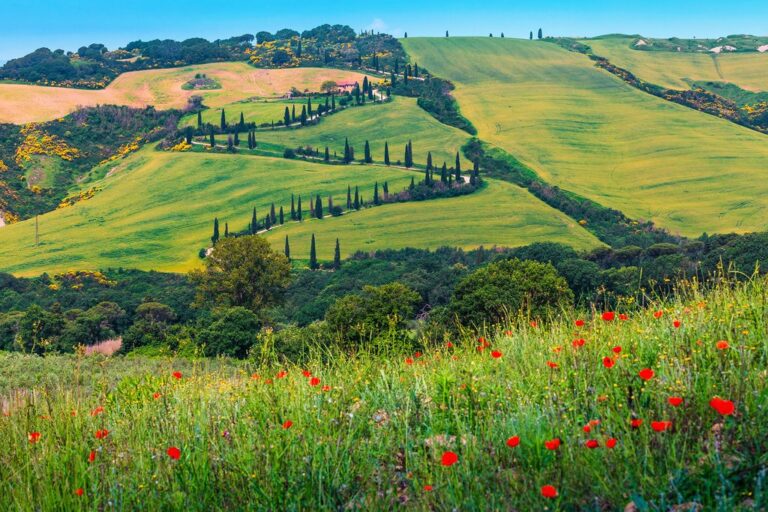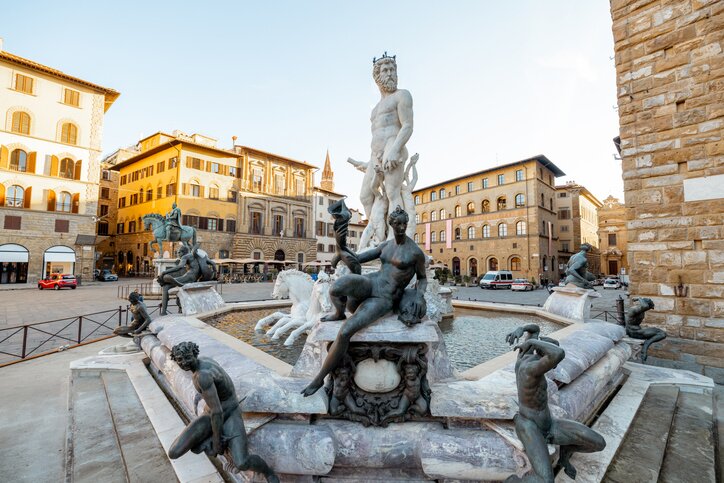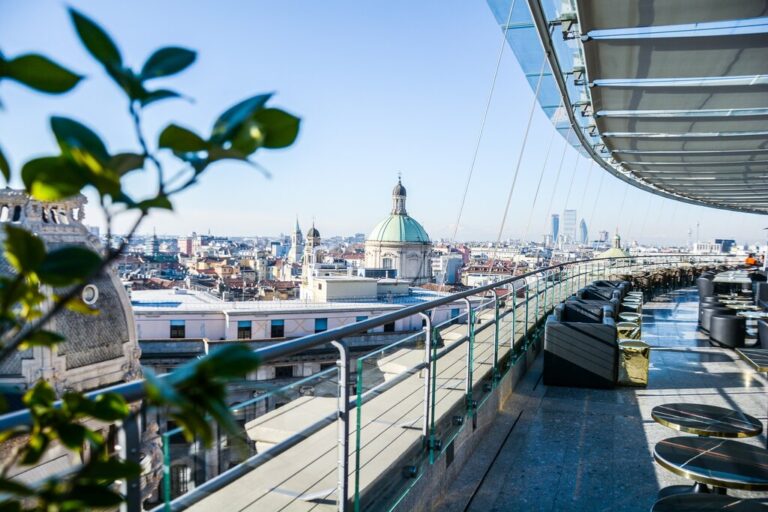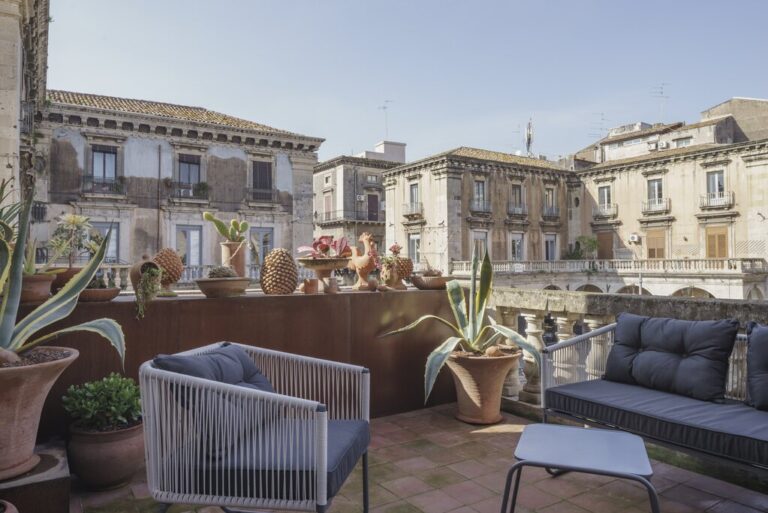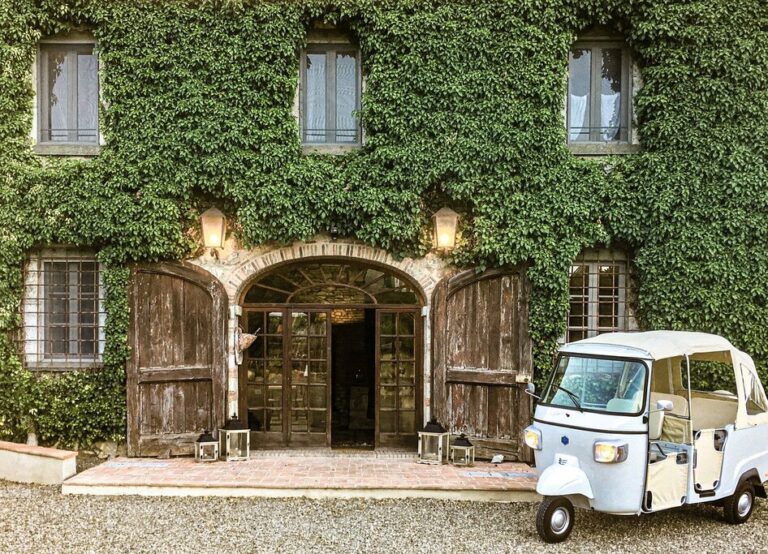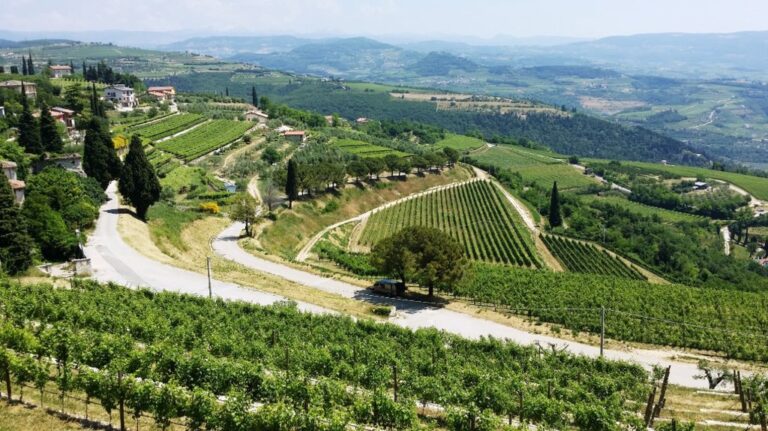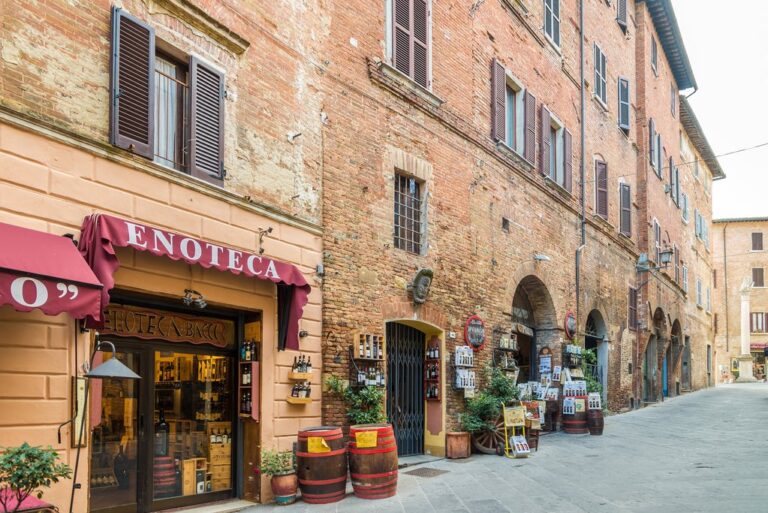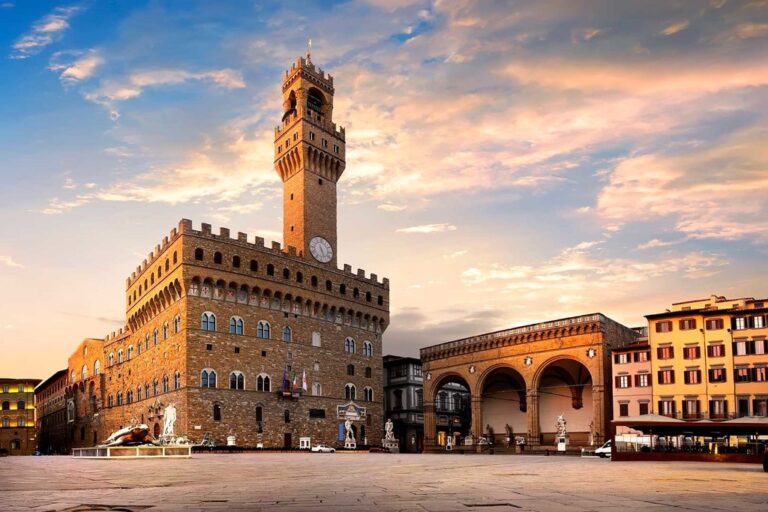Off-the-Beaten-Path Greece & Italy Road Trip: Lake Garda, Bologna, Tuscany, Olympia, Nafplio, & More – 21 Days
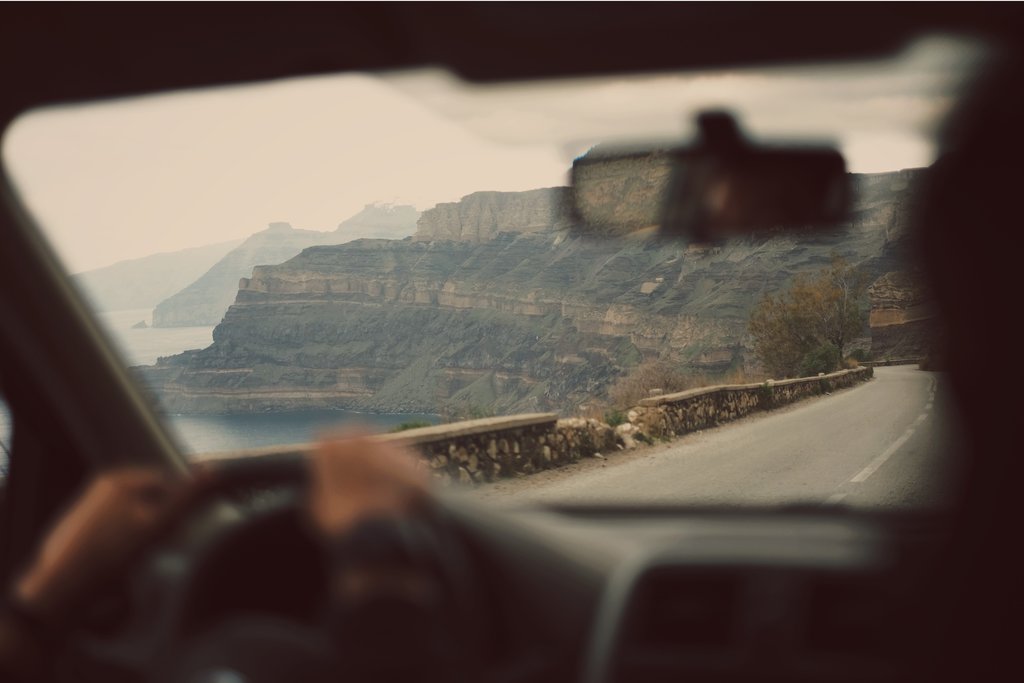
Explore the back roads and small villages that characterize the countrysides of both Italy and Greece on this three-week road trip. You’ll visit well-known highlights, like Florence, charming Tuscan hill towns, and the first Olympic site in Olympia, as well as some places a bit off the beaten path: Romeo and Juliet’s Verona, the medieval villages of the Peloponnese, the wineries of Nemea, and more. With full control of the daily driving schedule, you’ll have time to plan for spontaneous stops for coffee, for shopping at roadside markets, and for late-afternoon beach breaks.
Highlights
- Sample classic ham and cheese production in Parma
- Tour Florence’s beautiful medieval piazzas & cathedrals
- Try world-famous wine in Chianti and Nemea
- See archaeological sites dating from the Neolithic period to Roman times
- Enjoy Mediterranean sunshine on Voidokoilia Beach
Brief Itinerary
| Day | Highlights | Overnight |
|---|---|---|
| Day 1 | Arrive in Milan & Drive to Lake Garda | Lake Garda |
| Day 2 | Guided Tour of Lake Garda | Lake Garda |
| Day 3 | Lake Garda to Verona & Guided Tour | Verona |
| Day 4 | Wine Tour from Verona | Verona |
| Day 5 | Drive from Verona to Bologna, Prosciutto & Parmesan Tour | Bologna |
| Day 6 | Ferrari Museum & Drive to Florence | Florence |
| Day 7 | Florence Highlights and Food Tour | Florence |
| Day 8 | Florence to Siena & Chianti Wine Tasting | Siena |
| Day 9 | Walking Tour of Siena | Siena |
| Day 10 | Day Trip to Volterra & San Gimignano from Siena | Siena |
| Day 11 | Siena to Ancona & Overnight Ferry to Patras | Overnight Ferry |
| Day 12 | Arrive in Patras & Drive to Olympia | Olympia |
| Day 13 | Explore the Olympia Archaeological Site | Olympia |
| Day 14 | Olympia to Pylos & Palace of Nestor | Pylos |
| Day 15 | Castles of Pylos & Optional Boat Tour in Navarino Bay | Pylos |
| Day 16 | Drive to Mystras & Kalamata Olive Tour | Mystras |
| Day 17 | Areopoli & Mani Peninsula Driving Tour from Mystras | Mystras |
| Day 18 | Citadel of Mystras & Drive to Nafplio | Nafplio |
| Day 19 | Mycenae and Epidaurus Day Trip | Nafplio |
| Day 20 | Nemea Winery Exploration | Nafplio |
| Day 21 | Nafplio to Athens and Depart |
Detailed Itinerary
Day 1: Arrive in Milan & Drive to Lake Garda
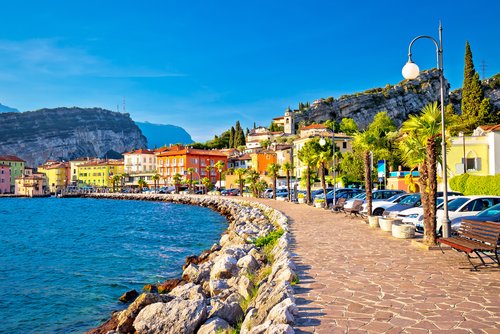
Welcome to Italy! After arriving at the airport you will pick up your rental car and drive to Lake Garda, where spectacular natural beauty meets charming Italian villages. Lake Garda is the biggest lake in the region, and you’ll have time to discover what makes it so special. The northern villages of Bardolino, Riva, Malcesine, Gardone, and Limone are smaller and have a more romantic mountain village feeling. The southern towns of Sirmione and Desenzano are somewhat bigger, with vibrant nightlife, trendy bars and restaurants, and plentiful accommodation options.
The town of Sirmione sits on a narrow peninsula on the south end of the lake and is known for its famous healing waters and its many historical sites, including the striking 13th-century Rocca Scaligera. This fortress is one of Italy’s best-preserved medieval castles and features a restored stone harbor. Sirmione is also famous for its ancient Roman villa, the Catullo Grottoes, which dates back to the 1st century BCE. The villa is situated on the northernmost tip of Sirmione’s peninsula and commands unparalleled views of the lake. Today, visitors can tour the grounds and ruins of the grand villa to see how ancient Rome’s rich and powerful citizens lived and built their homes.
After checking in to your hotel, head out to explore Sirmione on foot. Have a peaceful walk around Sirmione Park for great views from the peninsula. Then grab a gelato and go for a leisurely stroll along the town’s beautiful promenade. Relax on a bench and watch boats go by as the evening draws near. Head to one of the town’s many excellent restaurants for a dinner featuring fresh-caught fish from the lake. A great spot to find authentic food is Sirmione’s main square, Piazza Carducci.
Day 2: Guided Tour of Lake Garda
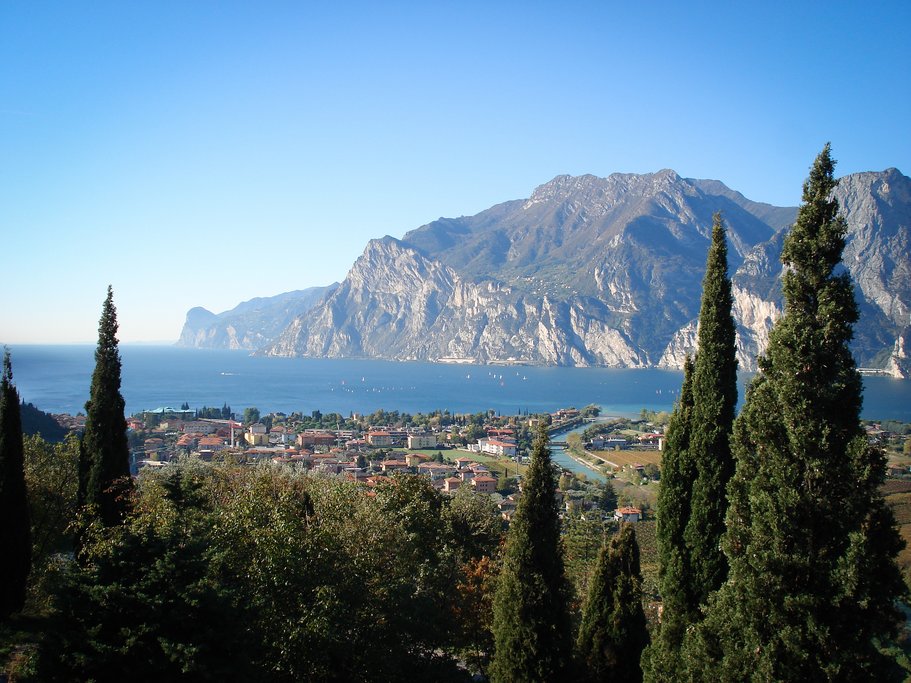
After breakfast, you’ll meet your guide in the center of Sirmione for a half-day tour of Lake Garda on land and water. Sirmione and neighboring Desenzano del Garda are steeped in history. Your guide will take you on a tour of these two villages, hopping between them using the lake’s ferry service. If you’d like to visit other villages with your guide, that can also be arranged in advance. During your tour, admire how the landscape changes around the lake, noting that the south is much flatter and less mountainous than the north, but also beautiful.
Sirmione is situated on a long peninsula that juts into the lake, making its location and views unique. The village itself is very pretty, with colored houses and cobbled streets waiting to charm you. You’ll visit the two main sites with your guide: the Grotto of Catullus and Scaliger Castle. The grotto was actually a large Roman mansion built for the poet Catullus. It was very common for patrician families to construct their villas around the lakes, inspired by the tranquility of the water and views of the mountains. The 14th century Scaliger Castle overlooks Sirmione and Lake Garda. For an unrivaled view across the lake, you can climb to the top of the castle up narrow stairs.
Take a short and scenic ferry ride with your guide to Desenzano. Explore the lakefront, old port, and winding streets, and learn about ancient history when visiting the castle and Roman Villa. If you’re interested in delving even further back in time, there is also the Bronze and Stone Age Museum in Desenzano (the G Rambotti Museo Archeologico). Wander through the center and check out the variety of shops, ranging from high-end designers to smaller boutiques, and if you are here on a Tuesday, don’t miss out on the market!
Towards the end of the day, enjoy some leisurely free time to explore at your own pace. We suggest hopping over to Peschiera del Garda, where you can pick from the following activities:
- Visit the Roman archeological sites of the Palazzina Storica Museo, and the Sanctuary of Madonna del Frassino.
- Hike to see the Waterfall of Varone. After, enjoy wine at Cantina Zeni and the Museum of Wine, set inside the Zeni Winery overlooking Lake Garda.
- Enjoy nature in Peschiera at the Hruska Botanical Garden, where you can find species from every part of the world from the Himalayas to Africa.
- Shop for and sample local food and wine. Producers sell sweet and savory treats, including tortellini, formaggella di tremosine (a soft cheese), honey, and sbrisolona (a delicious crumble cake). Vineyards surround Lake Garda, producing Bardolino wine, grappa, and limoncello.
We’d recommend finding a great spot for dinner in your favorite town. Fish is a specialty here- try delicious fresh trout, fish risotto, or alborelle pasta.
Day 3: Lake Garda to Verona & Guided Tour
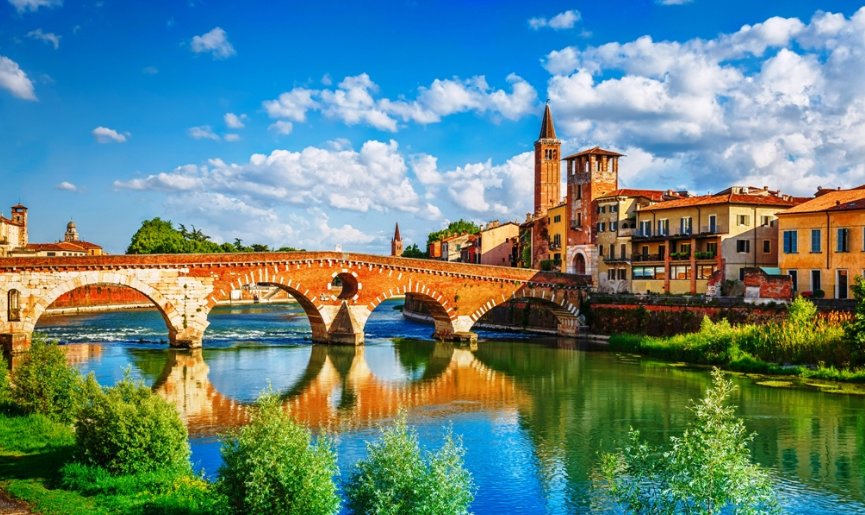
Drive east to the city of Verona after breakfast, the inspiration for Shakespeare’s most famous love story. After settling into your hotel, you’ll head out to savor the romantic city with a local guide. You’ll see for yourself why this city is now a UNESCO World Heritage site. Apart from being the setting of Romeo and Juliet, Verona is rich in history and archaeological importance.
Your walking tour will start with one of Verona’s most notable landmarks, the Arena in Bra Square. Still used today, this ancient Roman amphitheater is one of the best-preserved of its kind. From there, wander through the cobblestone streets and arrive at the central Piazza Bra, the largest square in the city and the perfect spot to delve into the importance of the ancient economic and political life in the quaint market Piazza delle Erbe.
Nearby, you’ll visit the house of Verona’s famed lovers and see Juliet’s balcony and the Casa di Giulietta, said to have inspired Shakespeare’s Romeo and Juliet. However, Verona isn’t only known for its romance. Continue your tour and learn more about why Verona holds such an important place in Northern Italy’s medieval history and visit the former political center Piazza dei Signori.
After your tour, take the rest of the day to explore on your own. Spend some time seeing inside the Roman Theater and Archaeological Museum. Admire the impressive archaeological feats before heading over to the Castelvecchio. First, cross the Castelvecchio Bridge, constructed in the 1350s. You’ll travel back in time as you walk over its red brick and take in the incredible scenery of the Adige river from this ideal vantage point. As you reach the other side, you can visit the Castelvecchio Museum. This small castle, built for military purposes, is a lovely example of Gothic architecture.
Take note of your guide’s recommendations for which restaurants not to miss for the best local dishes, and watch the sunset over dinner.
Day 4: Wine Tour from Verona
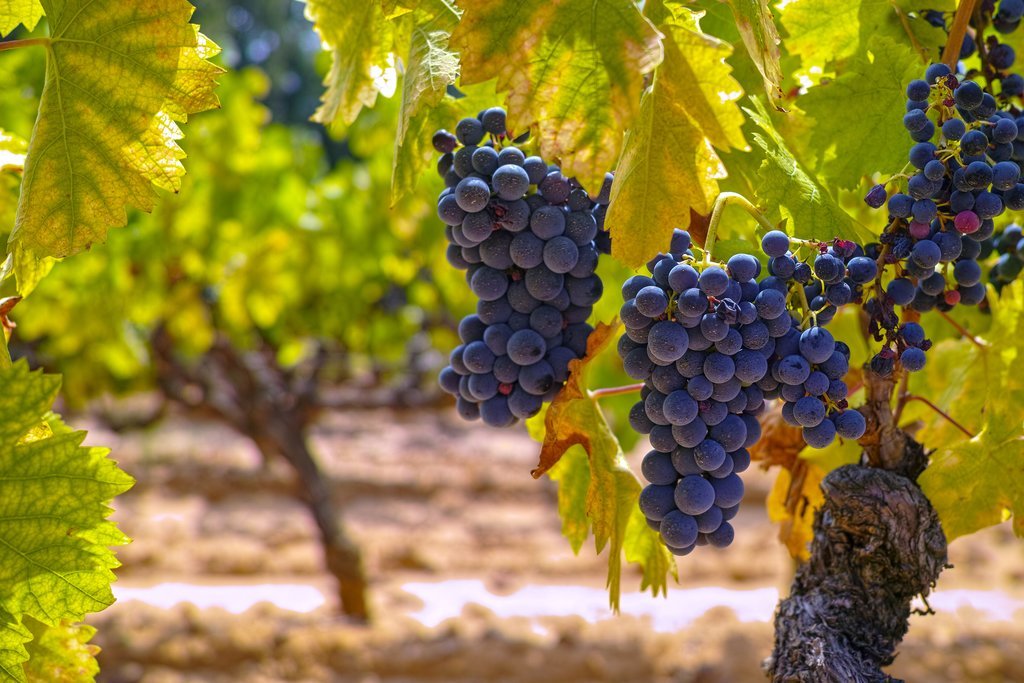
After a relaxed breakfast, head out for a delightful half-day wine tour in the vineyards of the Valpolicella region, surpassed only by Chianti and Montepulciano d’Abruzzo in terms of red wine production. The name, which comes from a mix of ancient Latin and Greek, translates to “valley of many cellars.”
This sprawling district in the Veneto region sits between the Alps foothills and the surrounding valleys of the Lessini Mountains. Valpolicella’s rich, alluvial soils cultivate some of the world’s best-quality grapevines, which produce four styles of revered red wines: dry, classic Amarone, spicy cherry Valpolicella Ripasso, sweet Recioto, and lively, accessible Valpolicella. With such a wide range of flavors, there’s a wine for every palate.
You’ll stop at two local wineries to learn about the production process and to tour the cellars, seeing how wine barrels are stored for aging. You’ll have a couple of tastings to discover the different flavors and compare and contrast before heading back to Verona.
In the afternoon, explore the city of Verona on your own. Head to the Giusti Garden in the east of the city, located just behind the Giusti Palace. Stroll through the maze of lawns, manicured hedges, and Greek statues that adorn its walkways and appreciate the Renaissance style. For dinner check out the Old Town area and find a cozy restaurant where you can spend your evening.
Day 5: Drive from Verona to Bologna, Prosciutto & Parmesan Tour
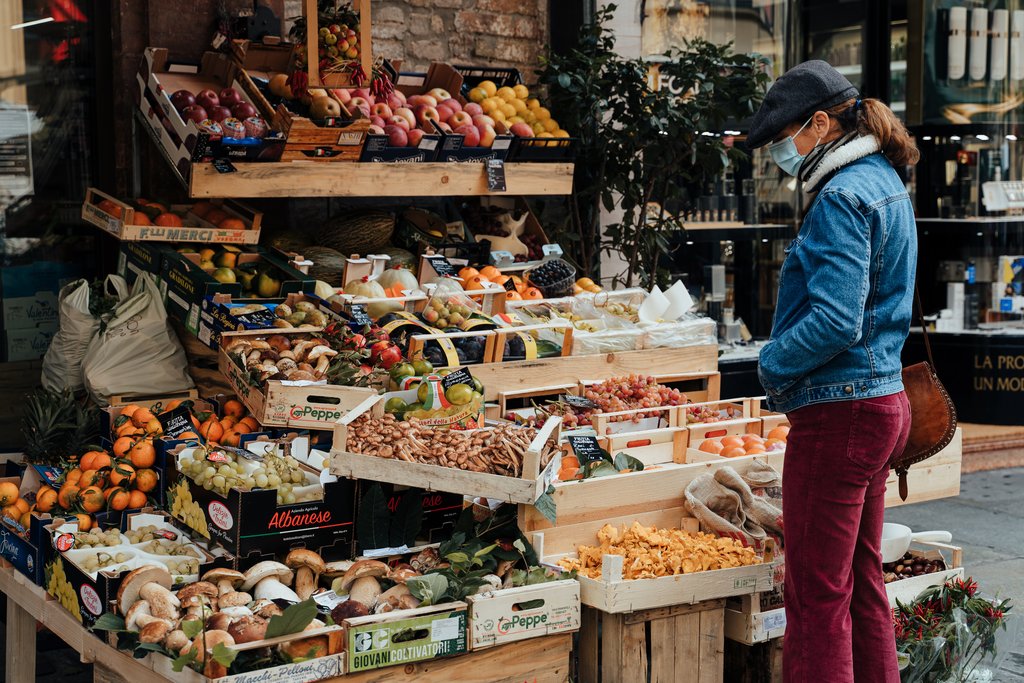
Hit the road this morning from your drive from Verona to Bologna. On the way, make a stop at the capital of Prosciutto and Parmesan cheese—the city of Parma, in the Emilia-Romagna region of Northern Italy. The city is famous for its ornate medieval architecture, the beautiful surrounding countryside, and, of course, the food.
Start the day at the Parmigiano Cheese Factory, where your tour starts with a brief history of Parmigiano Reggiano Cheese. After, proceed inside the factory to see the production of the cheese, which begins with the cheesemakers pulling the cheese from the milk vats. Your next stop is the seasoning and storage rooms to see the final stages of production, before ending the tour with a tasting of various-aged cheeses.
Your next stop is in the idyllic hills of Langhirano, home of Prosciutto di Parma ham. Learn about the historical and cultural aspects of ham production, then head into the cold room to see how the meat is stored. You’ll learn about every step of the process: how hams are selected, the salting, and finally dry storage. The final stage is spillatura, a process where the Inspector of the Consortium selects the finest cuts before branding them with the famous Crown of Parma seal.
After the two stops, enjoy lunch at a local family-owned restaurant, where you’ll sample typical Parma fare (including, of course, Parmigiano Reggiano cheeses and Parma ham), as well as other delicacies like torta fritta, tortelli erbetta, zucca, and more.
After lunch drive to Bologna and spend the afternoon exploring the city on your own. A good place to start is the Piazza Maggiore, a sprawling central plaza surrounded by the city’s oldest buildings. From here you can visit the City Hall, the 14th-century Basilica di San Petronio, and the medieval Asinelli and Garisenda Towers, which flank the Piazza.
If there’s time, head to the 11th-century University of Bologna to view the Anatomical Theater, formerly used by students dissecting cadavers, and stroll the medieval university grounds. On the way, stop to see the former Jewish Ghetto, then continue to the Pinacoteca Nazionale di Bologna, the National Art Gallery. This building also houses the Academy of Fine Arts.
In the evening, explore the city via the medieval porticos, a network of covered walkways that connect city landmarks, museums, and neighborhoods while protecting pedestrians from snow, rain, and the hot summer sun. Visitors with an eye for fashion will enjoy browsing the designer boutiques and the medieval Quadrilatero market district for the perfect Italian leather shoes or for gifts to bring home. Bologna is famed for its bustling markets and food scene. The Mercato di Mezzo, also in the Quadrilatero area, is worth a visit. It’s the best place in town for an aperitivo, and is full of bustling bakeries, restaurants and wine shops.
Day 6: Ferrari Museum & Drive to Florence
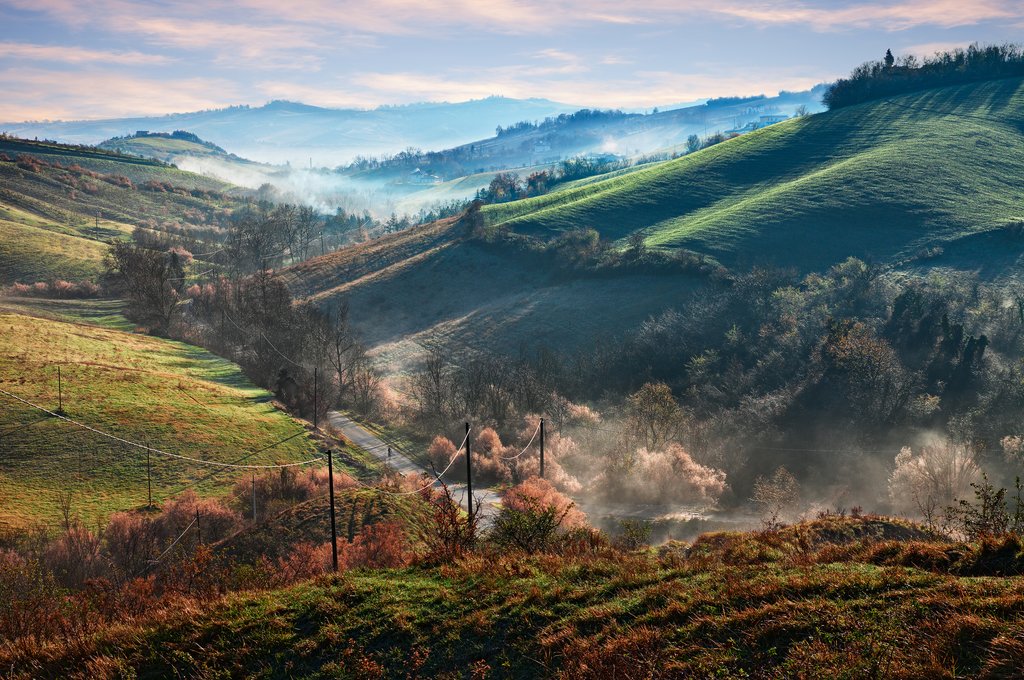
Start your morning with a coffee and a drive to the land of Ferrari—Maranello. Here you’ll tour the Ferrari factory and Ferrari museum as you learn about the history and impact of this incredible sports car.
The Ferrari Gallery & Museum, though owned by the Comune of Maranello, has been operated directly by Ferrari since 1995. Today more than ever it is the central location of Ferrari’s brand, where the company’s past, present, and future are preserved for visitors to experience.
The Gallery and Museum is divided into four areas, each tailored to a specific branch of the Ferrari family. Fans of competitions, visitors passionate about classic cars, and even casual enthusiasts will each find something to discover in these incredible displays. See the Formula 1 exhibit, explore technological innovations, browse photography displays, and, of course, admire the famous cars themselves.
Afterward, continue to Florence.
Day 7: Florence Highlights and Food Tour
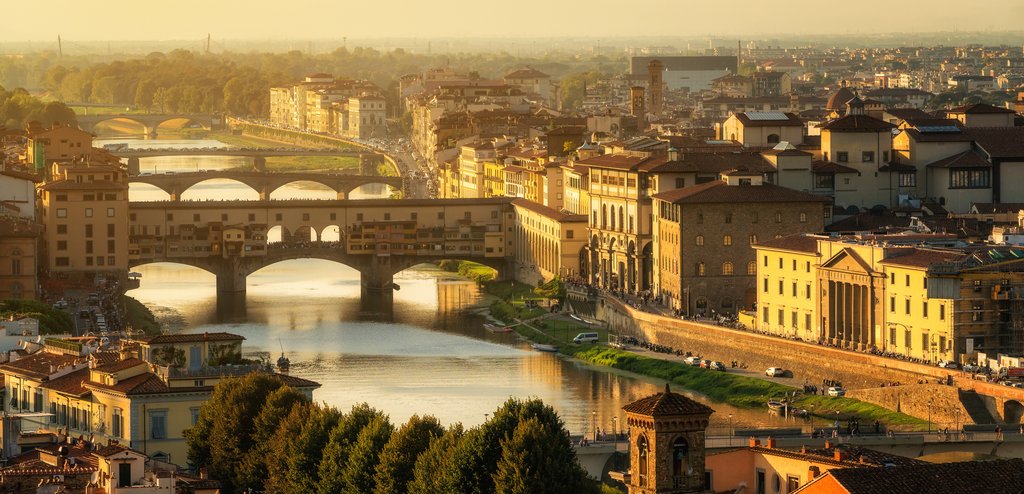
Spend the day exploring the city’s top sites, starting with a guided half-day walking tour. Stroll through the picturesque historic center where you’ll find the most important squares and monuments: from the Piazza della Repubblica to the Palazzo Vecchio, you’ll explore the beautiful squares and architecture that make Florence so picturesque. Soak in the atmosphere before heading over to the Ponte Vecchio, where you can admire the Arno River.
You’ll then make a stop at the iconic Duomo, with its terracotta-tiled dome, where across the way Giotto’s Bell Tower and the Baptistery with its bronze doors create an unforgettable scene. Finally, with skip-the-line entrance tickets in hand, you’ll head to the Galleria dell’Accademia to see Michelangelo’s David. Your guide will share stories of Michelangelo and how this masterpiece came to be.
In the afternoon, head to Piazza Mattei where you’ll meet your local culinary expert and start things off with a traditional Italian aperitif at a quintessential wine bar. Sample Tuscany’s finest red wines and enjoy a plate of charcuterie while your tour guide delves into the history of Italian food and the significance of sharing a meal with family and friends.
From here, continue to the 16th century Jewish Quarter, formerly the Jewish Ghetto, known for its historic importance and tasty eats. The former ghetto sat facing today’s Piazza della Repubblica, between Via Roma, Via Tosinghi, and Via Brunelleschi. Before sitting down to eat, take a quick walk around the area as you learn about the historical and cultural significance of this neighborhood, which was established by the Medici family as a real estate venture. After your tour, enjoy local appetizers like fried artichokes.
Close the food tour with a plate of Italy’s famous pasta. Head to a local family-owned restaurant for an in-depth exploration of the different pasta shapes, cooking styles, and sauce pairings. Round out the meal the Italian way — with gelato and a strong coffee.
Chat with a local specialist who can help organize your trip.
Day 8: Florence to Siena & Chianti Wine Tasting
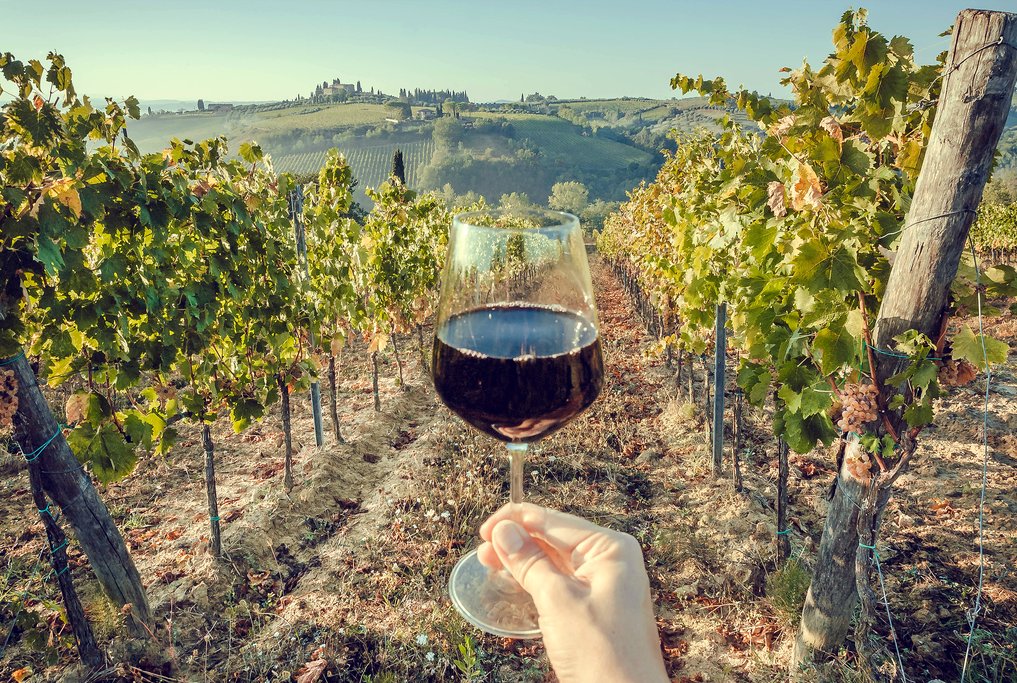
Travel from Florence to Siena, exploring the Tuscan countryside along the way. Stop in the Chianti Classico wine region and visit La Lastra Winery, a typical Tuscan winery. The unique characteristics of the local climate have made the region unfavorable to most crops, but ideal for growing wine grapes. Soak in the views, as alternating fields of olive orchards and vineyards characterize this idyllic landscape.
The Chianti wine, made primarily of Sangiovese grapes, is the local staple. Learn about the specific grapes and vines cultivated in the region as well as the entire process of wine production. From the vine to the glass, you’ll see firsthand all that goes into every bottle and the culture carried with it over time. Tour the cellars and vineyard of this local winery, then enjoy a wine tasting of four regional wines accompanied by local products. End your visit with a light lunch to pair perfectly with your palate.
In the late afternoon, continue to Siena, a medieval walled hilltop city that’s as famous for its historic architecture as it is for Palio di Siena, a popular horse race that takes place twice a year in the Piazza del Campo (main square).
Day 9: Walking Tour of Siena
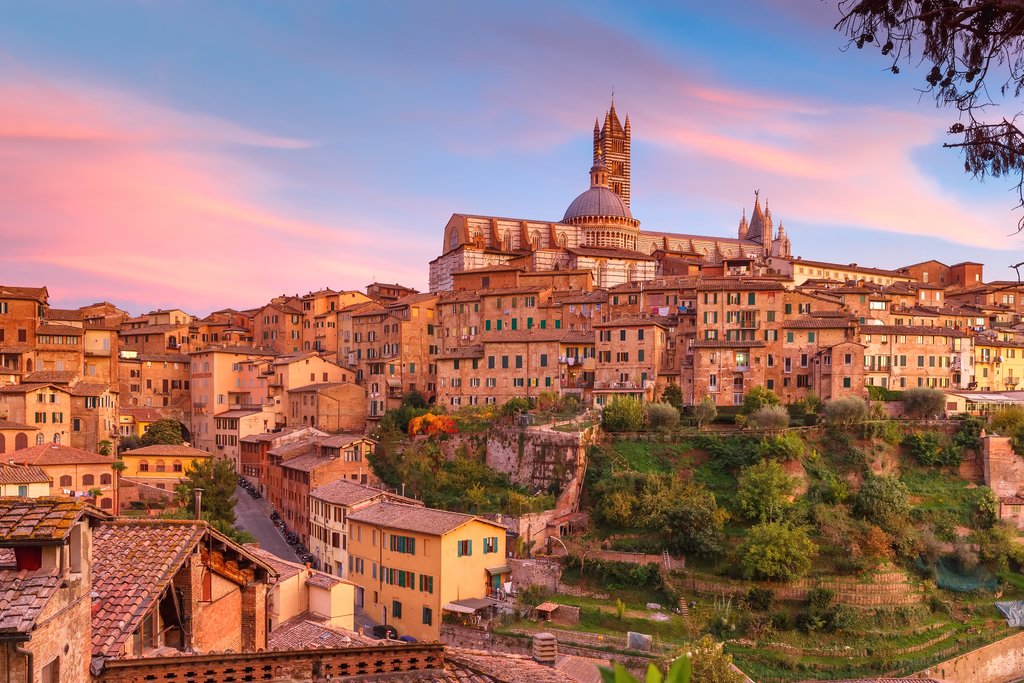
Spend the day exploring Siena’s highlights, such as the 13th-century Palazzo Pubblico, the Torre del Magnia (a bell tower with fantastic city views), the green-and-white-striped Duomo, and the Piccolomini Library, which is famous for its soaring Pinturicchio frescoes. Besides these, there’s the Museo dell’Opera Metropolitana art museum as well as Siena’s many churches, including the Basilica dell’ Osservanza, Santo Spirito, and Sanctuary of Santa Caterina.
Piazza del Campo is the central point of Siena, as many of the city’s roads radiate outward from this highly iconic and important square. The piazza began as a marketplace in the 12th century and has since become the cultural center of Siena, hosting events and tournaments between the city’s 17 contrade, or districts. Nowadays, the large public space is a great place to sit and spend some time at one of the many surrounding restaurants after visiting the square’s notable buildings. The Palazzo Publico and the Museo Civico are located at the lower end of the piazza. Notice how the palazzo (city hall) curves slightly. The architectural style is typical of Siena, from the burnt red brick to the black and white-colored shields representing the crests of Siena.
The highlight of the religious buildings in Siena is the Duomo di Siena. The cathedral is made entirely of marble and has served a symbol of the church’s wealth and status to residents and visitors since its construction in the 13th century. The style is eclectic, mixing Romanesque, Byzantine black and white ‘zebra stripes’ (representing the city’s colors), and Gothic arches and Parisian gargoyles similar to the Notre Dame. Its bell tower is 253 feet tall and is visible from many points of the city. Inside the church is really where the magic begins. The black and white marble extends to 56 different religious scenes inlaid to the cathedral’s floor. Take your time to explore the interior fully, and be sure not to miss the Piccolomini Library.
After your tour, head to Via di Città and walk up the ancient street. The road connects to Banchi Di Sopra, which was a part of the Via Francigena pilgrimage route. The street is now a great place to shop with a variety of small local crafts and designer boutiques.
Day 10: Day Trip to Volterra & San Gimignano from Siena
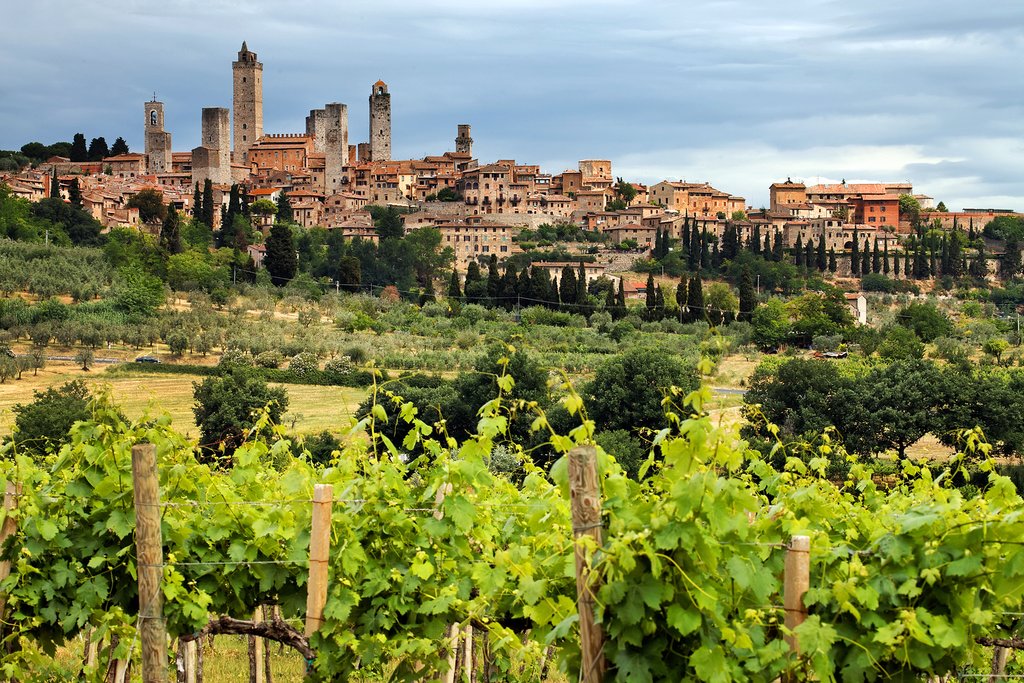
Siena makes a great home base to explore Tuscany’s bucolic countryside and visit the historic medieval villages that dot the rolling green hills.
First, you’ll visit San Gimignano, a quintessentially Tuscan village in that it’s comprised of medieval buildings perched atop one of the iconic Tuscan hills. Located in the Elsa Valley, it’s known for producing Vernaccia di San Gimignano, a white wine with floral and fruity notes. However, San Gimignano is most famous for the stone towers dominating its skyline, as well as its 13th-century walls and medieval plazas and churches. It’s for these reasons the village is a UNESCO World-Heritage Site.
You’ll be able to snap plenty of photos on a walking tour of the town. Also, be sure to pop in at one of San Gimignano’s famous gelaterias, which have an earned reputation for producing some of the best gelato in the world.
Next, you’ll head to Volterra, a walled town perched high on a hilltop with deep roots in Etruscan and Roman history. To this day, visitors can still see parts of the Etruscans’ ancient protective walls and gates as they enter. Most of the surviving architecture dates from the medieval period, especially around Piazza dei Priori and its narrow, surrounding side streets. In the central square, the bell tower of Palazzo dei Priori offers impressive views across the village and into the surrounding countryside. Venture inside the City Hall, as well as the Volterra Cathedral to see frescoes, the entrance constructed of locally quarried marble, and a unique ceiling. The village also hosts the ruins of an ancient Roman theater.
Volterra is also known for its alabaster production. Stroll through the artisanal shops, browse the local handicrafts, and see for yourself why this town is famed for this beautiful stone. The old town center has many local shops, art galleries, palaces (such as Palazzo Viti), and gelaterias for you to peruse.
At the end of the day, return to Siena.
Day 11: Siena to Ancona & Overnight Ferry to Patras
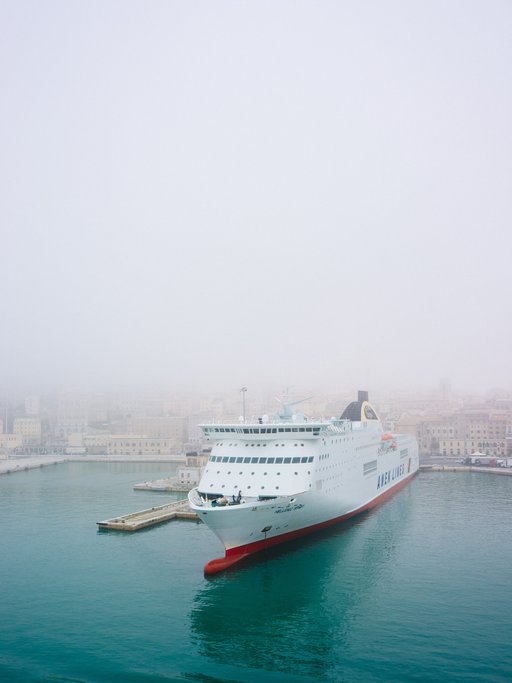
Make the drive from Siena to Ancona, located just under three hours to the east on the coast of the Adriatic Sea. Here, you’ll board an overnight ferry bound for Patras, which sits on the western shore of Greece’s mainland. Take this day as an opportunity to relax, as the ferry is equipped with all the latest amenities: a full restaurant, comfortable cabins, and plenty of spots to sit and enjoy the views as you cross the Adriatic.
Day 12: Arrive in Patras & Drive to Olympia
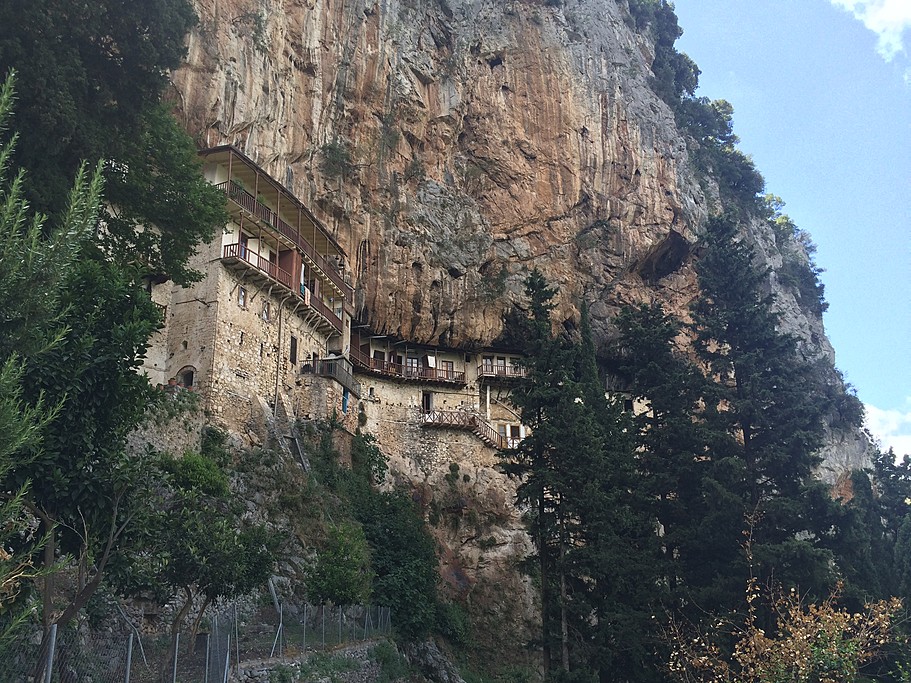
Upon your arrival at Patras port, you will pick up your rental car and start your trip to Olympia.
Make a stop at Patras’ famous square Platia Georgiou to admire the architecture of the surrounding historical buildings. For a more vibrant feeling of everyday life, walk a few blocks to Olga’s Square, a favorite hangout of the city’s youth.
On your way out of the city, stop to admire the ancient Roman Odeon of Patras, a 2,000-year-old building complex that consists of a theater and several temples, and one of Patras’ best-known archaeological sites.
Once you leave Patras, head south parallel to the sea until you reach the area of Katakolo, after which you will head inland to reach Olympia. If you have the time, it’s worth a stop to visit the museum of ancient Greek technology in Katakolo, which houses a full working copy (in the original size) of the Antikythera mechanism, considered the first-ever analog computer and the oldest device that could predict astronomical positions and eclipses.
Once you reach Olympia, settle into your hotel and take the rest of the day to relax.
Day 13: Explore the Olympia Archaeological Site
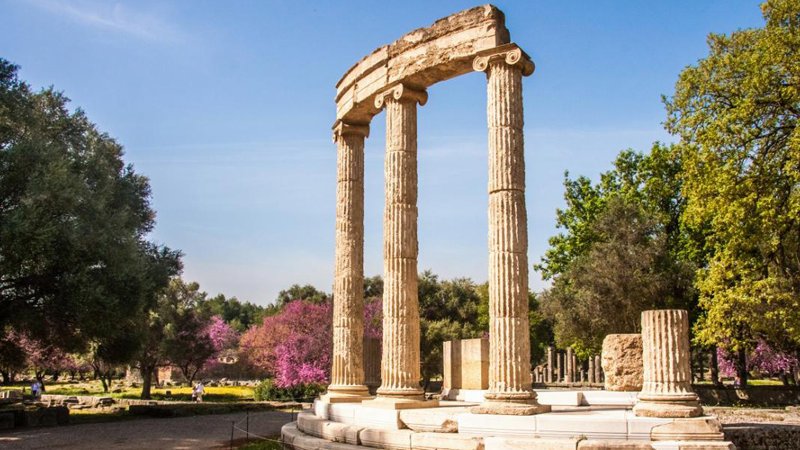
Explore the site of the first Olympic Games at the archaeological site of Olympia. There’s plenty to cover—it’s one of the largest sites in the country, surrounded by wild olives and plane trees. Your comprehensive guided tour will take you under the grand temple columns, past the Sanctuary of Olympian Zeus, and through the onsite Archaeological Museum.
There will also be free time after the tour to explore the site on your own. Scope out the treasuries, sacrificial altars, and stadium once used by the ancient world’s best athletes. The natural landscape surrounding the site is also full of opportunities for a day hike if you’d like to put your muscles to use.
After a busy day of sightseeing, rest up in Olympia before heading on to your next destination in the morning.
Day 14: Olympia to Pylos & Palace of Nestor
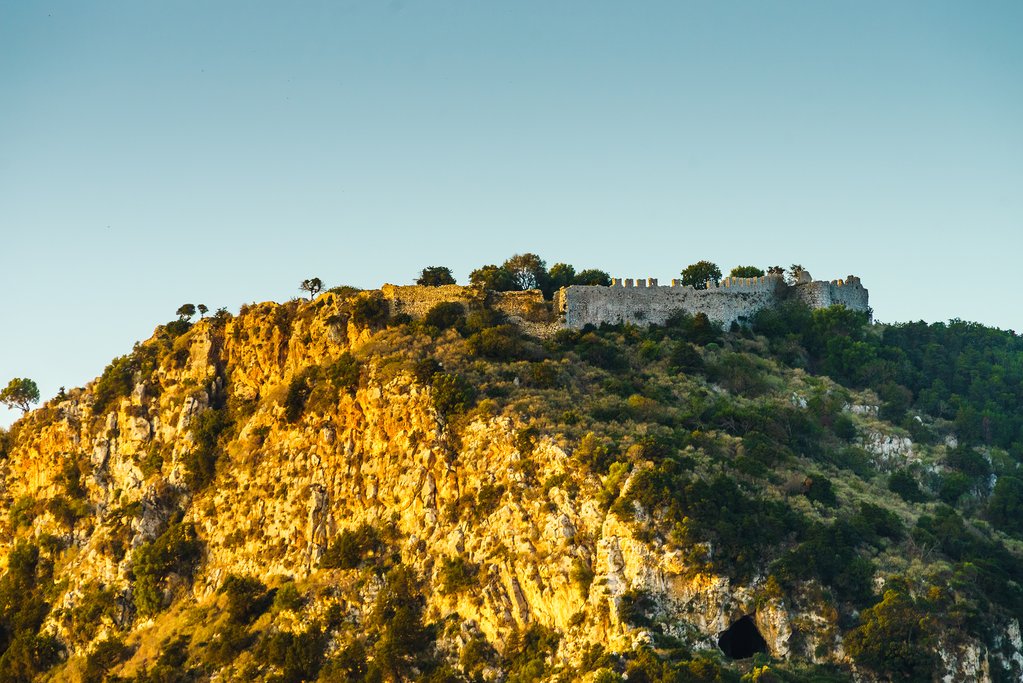
Head to the Palace of Nestor in “sandy Pylos,” as it was known in Homer’s Iliad and Odyssey. The palace is one of the best-preserved Mycenean sites of its time, including the primary structure of the palaces as well as a larger Late Helladic settlement, with remnants of the fortified walls.
After your tour of the palace, you’ll visit the Pylos Museum, an impressive building that houses archaeological finds from excavations in the area of Pylia dating from the Neolithic period to Roman times.
The museum is divided into two rooms that display the area’s most significant findings: signet rings, gold objects, urns, necklaces, and more from the vaulted tomb of Kokounara in Paleochora. You’ll also see artifacts from the Hellenistic tomb of Tragana as well as many other grave goods, pottery and copper utensils, and a warrior’s boar tusk helmet.
Afterward enjoy the Greek sun at Voidokoilia Beach, with its pristine sandy beach with clear turquoise green waters, before continuing the drive. You’ll stay tonight in the seaside town of Pylos.
Day 15: Castles of Pylos & Optional Boat Tour in Navarino Bay

Map of Off-the-Beaten-Path Greece & Italy Road Trip: Lake Garda, Bologna, Tuscany, Olympia, Nafplio, & More – 21 Days
T4523
Tours & Itineraries
Get inspired by trips other travelers have loved
Cinque Terre and the Italian Riviera – 11 Days
History and Nature in Italy: Venice to Rome – 11 Days
Grand Cities and Classic Riviera Villages: Turin, Santa Margherita Ligure, Cinque Terre, & More – 12 Days
Best of Puglia: Lecce, Otranto, & Alberobello – 5 days
Cycling and Food Tour of Tuscany: Alba, Asti, Pienza, & Montepulciano – 8 Days
Rome, Perugia & Florence – 7 Days
Hotel Advice
Unique places to stay, curated by Big Time Holiday specialists
Hotel The Square Milano Duomo, Milan Hotels
Asmundo di Gisira, Catania Hotels
Tenuta CorteDomina, Tuscany Hotels
Best Experiences
Unique things to do, curated by Big Time Holiday specialists

